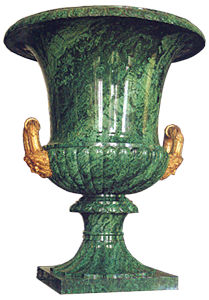Besides wanting new neoclassical buildings to display her knowlege of architecture, Catherine also wanted more room to effectively show off a great art collection she was assembling from art sales and auctions all over Europe. The Empress studied various proposals made to her - drawings and costs - finally accepting the designs of Veldten, which included a delightful hanging garden connecting the new proposed building to the old Winter Palace. When it was finished this was called the "Little Hermitage". As Catherine's art collection rapidly grew more space was required and designs of the French architect Vallin de la Mothe were used to build another pavilion to the north of the Little Hermitage and this building was called the "Old Hermitage".
Catherine's new Hermitage was both art gallery and a favorite place for her to entertain when she was living in the city. Within these splendid rooms she could relax with her friends, statesmen and Europe's intellectuals, impressing her guests with her power, culture and cordiality. As the Hermitage was 'her home' Catherine insisted on an informal atmosphere and she published rules of conduct that set the stiff European royal etiquette established by the rigid French court on its head. In Catherine's Hermitage rank meant nothing - moderation was the rule - swords, argument and conflict were, by order of her Imperial Majesty, to be left outside while comfortable dress. moderate drinking and good civilized conversation were the standards she enforced within.
After Catherine's addition of the Hermitage Theatre in the 1780's the next enlargement of the Hermitage took place from 1839-52 when Nicholas I asked the German architect Leo von Klenze to rebuild the "New Hermitage" in neoclassical style. Here, in the photograph above we see the city side of the Hermitage complex with von Klenze's famous portico with giant 15 foot tall Atlas figures carved from granite holding up the roof - which were the work of the Russian sculptor, Terebenev. This facade faces the Millionaya - Millionaire's Row.

Left: Nicholas I.
In 1838 Nicholas had seen the work of Leo von Klenze in Munich when visiting the King of Bavaria, Ludwig I. There Nicholas saw the Alte Pinakothek and the Glyptothek, two museums just built to designs of von Klenze. The Glypothek was a neo-Greek work and housed Ludwig's collection of classical sculpture. Nicholas was much impressed with von Klenze's work - the architect himself gave Nicholas a tour of his buildings. Nicholas admired the severe and regal proportions of the Glyptothek which were patterned on a classical temple. These were architectural ideals which harmonized with his goals for the organization of Russia. Nicholas asked immediately asked von Klenze to come to Petersburg to design buildings for him and the "New Hermitage" was the sole result of that invitation. Von Klenze came to Petersburg to begin the work, but it was completed by the famous Russian architect, Stasov, who implemented many changes.
Most of the changes were done to the interior. Von Klenze had designed everything - right down to the furniture and stair railings. Some of the furniture was produced - magnificent, heavy, eagle and acanthus decorated pieces - but Nicholas decided to transfer neo-classical furniture from other palaces to the New Hermitage. Nicholas had no shortage of beautiful furniture from which to choose, and the pieces that were selected harmonized very well with the new building.
 One of the chief ornaments of the New Hermitage were huge Empire-style vases made of Russian semi-precious stones mounted in gilt-bronze. These vases took years to produce. Once the stone had been selected - rich dark-blue lapis lazuli, jasper, pink rhodonite or various porphyries from the Ural Mountains - a craftsman would begin the work of turning the stone to designs set by the Tsar's Imperial Cabinet. Often times these designs would be the work of the foremost architects of the day. When the vases were completed they were exhibited on the Jordan staircase of the Winter Palace at Christmas and Easter. The Tsar would pick the pieces he wanted and the rest were given away as gifts. Among the most treasured of these vases were those made of lush green Russian malachite, created in a laborious mosaic technique.
One of the chief ornaments of the New Hermitage were huge Empire-style vases made of Russian semi-precious stones mounted in gilt-bronze. These vases took years to produce. Once the stone had been selected - rich dark-blue lapis lazuli, jasper, pink rhodonite or various porphyries from the Ural Mountains - a craftsman would begin the work of turning the stone to designs set by the Tsar's Imperial Cabinet. Often times these designs would be the work of the foremost architects of the day. When the vases were completed they were exhibited on the Jordan staircase of the Winter Palace at Christmas and Easter. The Tsar would pick the pieces he wanted and the rest were given away as gifts. Among the most treasured of these vases were those made of lush green Russian malachite, created in a laborious mosaic technique.
Next photograph: The Italian Gallery of the Hermitage Museum
For a small map of the St. Petersburg area click here.
To see a large map of the center
of St. Petersburg go here.
Comments on the website should be sent to Bob
Atchison.

